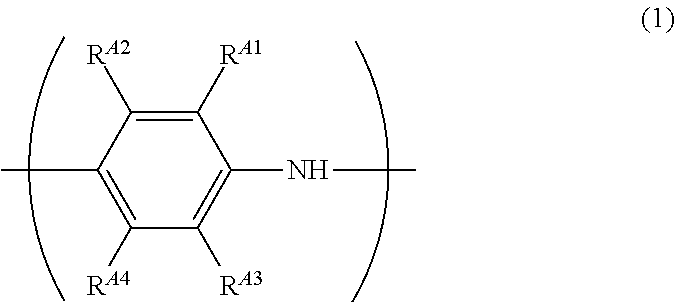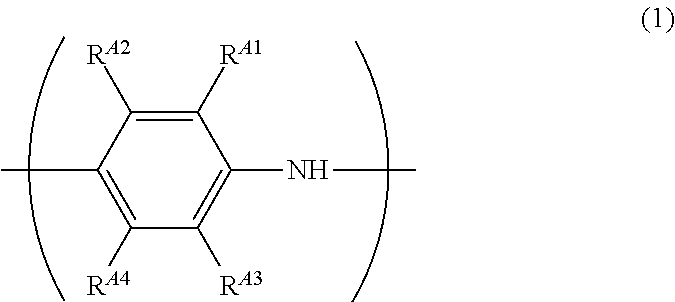Conductive polymer composition, coated article, patterning process and substrate
a technology of conductive polymer and coated article, which is applied in the direction of conductive materials, conductive materials, domestic applications, etc., can solve the problems of difficult to change the composition ratio of the associate formed by the amino group and the acidic substituent in the polyaniline, the shape and sensitivity of the resist change, and the lithography is not favorable, so as to achieve good pattern profile, high sensitivity, and high resolution
- Summary
- Abstract
- Description
- Claims
- Application Information
AI Technical Summary
Benefits of technology
Problems solved by technology
Method used
Image
Examples
production example 1
[0121]206 g of sodium salt of monomer 1 was dissolved in 1,000 mL of ion-exchanged water. An oxidizing agent solution in which 1.14 g of ammonium persulfate had been previously dissolved in 10 mL of water was added dropwise thereto over 20 minutes under stirring at 80° C., and the solution was stirred for 2 hours.
[0122]To the obtained sodium polystyrene sulfonate-containing solution were added 1,000 mL of sulfuric acid diluted to 10% by mass and 10,000 mL of ion-exchanged water, and about 10,000 mL of the polystyrene sulfonic acid-containing solution was removed by ultrafiltration. To the residue was added 10,000 mL of ion-exchanged water, and about 10,000 mL of the solution was removed by ultrafiltration. This ultrafiltration operation was repeated 3 times.
[0123]Further, about 10,000 mL of ion-exchanged water was added to the obtained filtrate, and about 10,000 mL of the solution was removed by ultrafiltration. This ultrafiltration operation was repeate...
production example 2
[0131]A solution in which 37.5 g of Monomer 2, 12.5 g of lithium salt of Monomer 1, and 3.04 g of dimethyl 2,2′-azobis(isobutyrate) had been dissolved in 112.5 g of methanol was added dropwise into 37.5 g of methanol with stirring at 64° C. under a nitrogen atmosphere over 4 hours. The solution was kept stirring at 64° C. over 4 hours. It was cooled to room temperature, and then added dropwise into 1,000 g of ethyl acetate with vigorous stirring. The obtained solid was filtered off, and dried in vacuo at 50° C. for 15 hours to give 47.1 g of white polymer.
[0132]The obtained white polymer was dissolved in 424 g of methanol, and the lithium salt was converted to sulfo group using ion-exchange resin. The obtained polymer was analyzed by 19F, 1H-NMR, and GPC to give the following results.
[0133]Composition of the copolymer (molar ratio) Monomer 1:Monomer 2=1:1
[0134]Weight average molecular weight (Mw)=39,000
[0135]Molecular-weight distribution (Mw / Mn)=1.81
[013...
production example 3
Synthesis of Polyaniline-Based Conductive Polymer Composite Using Dopant Polymer 1
[0137]27.5 g of 2-methoxyaniline was mixed with a solution in which 41.1 g of Dopant polymer 1 obtained in Production Example 1 had been dissolved in 1,000 mL of ultrapure water at 25° C.
[0138]Into the resulting mixed solution was slowly added 45.9 g of ammonium persulfate dissolved in 200 mL of ultrapure water while stirring the mixed solution and keeping the temperature thereof at 0° C., to initiate reaction under stirring.
[0139]The obtained reaction solution was concentrated, and then added dropwise into 4,000 mL of acetone to obtain a green powder. The green powder was dispersed again into 1,000 mL of ultrapure water, and this dispersion was added dropwise into 4,000 mL of acetone to purify and recrystallize the green powder. This procedure was repeated 3 times. Then, the obtained green powder was redispersed in 2,000 mL of ultrapure water, and about 1,000 mL of water was removed by ultrafiltration...
PUM
 Login to View More
Login to View More Abstract
Description
Claims
Application Information
 Login to View More
Login to View More - R&D
- Intellectual Property
- Life Sciences
- Materials
- Tech Scout
- Unparalleled Data Quality
- Higher Quality Content
- 60% Fewer Hallucinations
Browse by: Latest US Patents, China's latest patents, Technical Efficacy Thesaurus, Application Domain, Technology Topic, Popular Technical Reports.
© 2025 PatSnap. All rights reserved.Legal|Privacy policy|Modern Slavery Act Transparency Statement|Sitemap|About US| Contact US: help@patsnap.com



